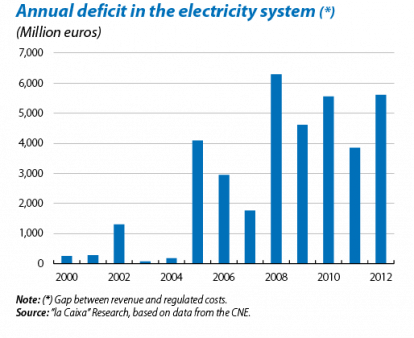The Spanish government has the difficult job of carrying out a far-reaching transformation of the economy to improve its competitiveness and ensure sustainability of the national accounts. The energy sector is not unrelated to this twofold objective. It is vital to slow up the dramatic increase in electricity prices seen over the last few years, which is affecting the economy's competitiveness, without aggravating any further the fragile financial sustainability of the public sector. The numerous measures adopted in the last few years indicate the efforts made to reach a solution, which nevertheless appears elusive.
Electricity prices have increased considerably over the last few years and, according to Eurostat figures, are among the highest for the euro area countries. Without taking taxation into account, the price for electricity paid by Spanish firms in the first half of 2013 was 25.3% above the average for the rest of the euro area. This difference goes up to 28.3% in the case of households. However, this kind of statistic must be used with great caution as the end price within each country can vary widely depending on the tariff. Prices can also vary between countries depending on how each one applies its industrial and social policies, either via measures contained in the state budget or directly in the final electricity bill.
In any case, the current structure of revenue and expenditure is still a burden for the public accounts. The revenue obtained by firms from their part of the regulated tariff is not enough to cover the regulated system costs. This gap, which the public sector must cover, has produced a debt that, by May 2013, totalled over 26 billion euros (2.5% of GDP). This is known as the tariff deficit.
The need to reform the system was therefore evident. The main line of action taken in an attempt to contain the tariff deficit focused on reducing costs. The government's first actions centred on containing the increase in the regulated part of the electricity tariff. This contains those costs that are not directly related to generating electricity, such as the transport and distribution of electricity, policies to encourage investment in renewable energies, subsidies for off-mainland supply, repayment of the debt accumulated due to the tariff deficit and costs for maintaining the necessary spare capacity. According to the government, regulated costs rose by around 15.7% annually between 2005 and 2013 (221% cumulative). The generation of renewable energies has been the focus of a large proportion of the cost-cutting measures approved in the last year. Payments have also been revised for the transport and distribution of electricity, as well as for capacity.
Although these measures are expected to reduce the deficit produced annually, they are unlikely to achieve this entirely. To do so, it would also be necessary to make headway with a combination of policies that involve: (1) transferring to the state budget those regulated concepts that pursue aims of a social or regional nature, and (2) the progressive liberalisation of the sector, reforming the method used to establish end prices for those consumers that come under the regulated tariff.
In conclusion, a definitive energy reform is vitally important for the Spanish economy as a whole but this is unlikely to be achieved easily. It must guarantee the elimination of the tariff deficit but, as the same time, encourage a competitive, efficient electricity industry that helps to reduce Spain's electricity costs.

